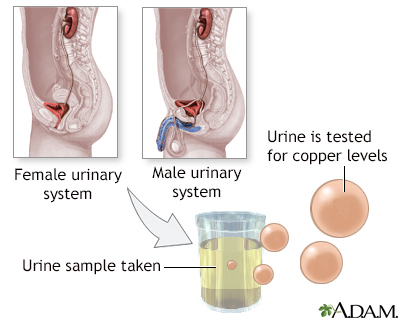24-hour urine copper test
Definition
The 24-hour urine copper test measures the amount of copper in a urine sample.
Alternative Names
Quantitative urinary copper
How the Test is Performed
A 24-hour urine sample is needed.
- On day 1, urinate into the toilet when you get up in the morning.
- Afterward, collect all urine in a special container for the next 24 hours.
- On day 2, urinate into the container when you get up in the morning.
- Cap the container. Keep it in the refrigerator or a cool place during the collection period.
Label the container with your name, the date, the time of completion, and return it as instructed.
For an infant, thoroughly wash the area where urine exits the body.
- Open a urine collection bag (a plastic bag with an adhesive paper on one end).
- For males, place the entire penis in the bag and attach the adhesive to the skin.
- For females, place the bag over the labia.
- Diaper as usual over the secured bag.
This procedure may take more than one try. An active infant can move the bag, so that the urine leaks into the diaper.
Check the infant often and change the bag after the infant has urinated into it.
Drain the urine from the bag into the container given to you by your health care provider.
Return the bag or container as instructed.
A laboratory specialist will determine how much copper is in the sample.
How to Prepare for the Test
No special preparation is necessary for this test. Extra collection bags may be needed if the sample is being taken from an infant.
How the Test will Feel
The test involves only normal urination, and there is no discomfort.
Why the Test is Performed
Your provider may order this test if you have signs of Wilson disease, a genetic disorder that affects how the body processes copper.
Normal Results
The normal range is 10 to 30 micrograms per 24 hours.
Note: Normal value ranges may vary slightly among different laboratories. Talk to your provider about the meaning of your specific test results.
The examples above show the common measurements for results for these tests. Some laboratories use different measurements or may test different specimens.
What Abnormal Results Mean
An abnormal result means you have a higher than normal level of copper. This may be due to:
- Biliary cirrhosis
- Chronic active hepatitis
- Wilson disease
Risks
There are no risks associated with providing a urine sample.
Gallery

References
Anstee QM, Jones DEJ. Hepatology. In: Ralston SH, Penman ID, Strachan MWJ, Hobson RP, eds. Davidson's Principles and Practice of Medicine. 23rd ed. Philadelphia, PA: Elsevier; 2018:chap 22.
Riley RS, McPherson RA. Basic examination of urine. In: McPherson RA, Pincus MR, eds. Henry's Clinical Diagnosis and Management by Laboratory Methods. 24th ed. Philadelphia, PA: Elsevier; 2022:chap 29.
Schilsky ML. Wilson disease and related disorders. In: Friedman LS, Martin P, eds. Handbook of Liver Disease. 4th ed. Philadelphia, PA: Elsevier; 2018:chap 19.